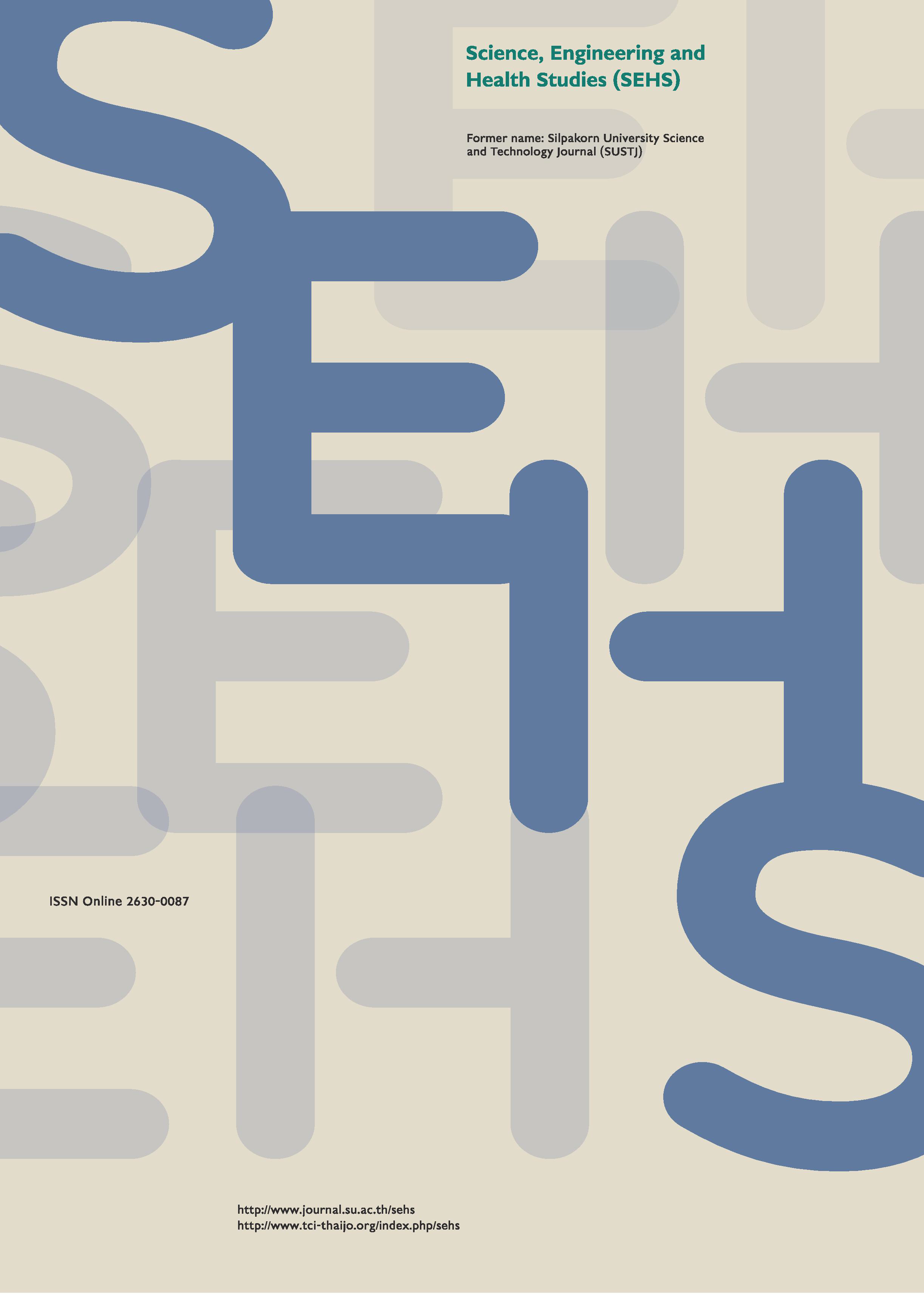Formulation of Andrographis tablet from the antisolvent semi-purified Andrographis extract
Main Article Content
Abstract
Andrographis paniculata extract, administered at 180 mg/day of andrographolide for 5 consecutive days, has been used to treat mild cases of severe acute respiratory syndrome coronavirus 2 (SARS-CoV-2). This research formulated 30 mg film-coated tablets of andrographolide, derived from a partially purified extract of Andrographis obtained using the antisolvent technique. The powdered extract was combined with microcrystalline cellulose and colloidal silicon dioxide to create core tablets through the wet granulation method. These core tablets were then film-coated. The Andrographis extract powder contained 40.27±1.18% andrographolide. The average weights of the core and film-coated tablets were 381.9 mg and 392.4 mg, respectively, each contained 31.0 of andrographolide. The average friability and hardness of the core tablets were 0.12±0.01% and 8.7±0.2 kg, respectively. The film-coated tablets completely disintegrated within 23 min, and the distribution of the extracted content in the tablet was uniform. The Andrographis tablets used in this study met all USP criteria.
Downloads
Article Details

This work is licensed under a Creative Commons Attribution-NonCommercial-NoDerivatives 4.0 International License.
References
Aiyegbusi, O. L., Hughes, S. E., Turner, G., Rivera, S. C., McMullan, C., Chandan, J. S., Haroon, S., Price, G., Davies, E. H., Nirantharakumar, K., Sapey, E., & Calvert, M. J. (2021). Symptoms, complications and management of long COVID: A review. Journal of the Royal Society of Medicine, 114(9), 428–442. https://doi.org/10.1177/01410768211032850
Bhagwat, D. A., & D’Souza, J. I. (2012). Formulation and evaluation of solid self microemulsifying drug delivery system using Aerosil 200 as solid carrier. International Current Pharmaceutical Journal, 1(12), 414–419. https://doi.org/10.3329/icpj.v1i12.12451
Chao, W.-W., & Lin, B.-F. (2010). Isolation and identification of bioactive compounds in Andrographis paniculate (Chuanxinlian). Chinese Medicine, 5, 17. https://doi.org/10.1186/1749-8546-5-17
Charupant, K., Nimnoi, S., Kongsuk, W., & Krabesri, S. (2017). Establishment of dissolution specification for Fa-Tha-Lai Capsules. Journal of Health Science, 26(1), 198–209. https://thaidj.org/index.php/JHS/article/view/154
Chaudhari, S. P., Bhadiyadra, M., & Dave, R. H. (2020). Evaluating the effect of the porous and non-porous colloidal silicon dioxide as a stabilizer on amorphous solid dispersion. Journal of Drug Delivery and Therapeutics, 10(5), 255–263. https://doi.org/10.22270/jddt.v10i5.4323
Guo, W., Liu, W., Chen, G., Hong, S., Qian, C., Xie, N., Yang, X., Sun, Y., & Xu, Q. (2012). Water-soluble andrographolide sulfonate exerts anti-sepsis action in mice through down-regulating p38 MAPK, STAT3 and NF-κB pathways. International Immunopharmacology, 14(4), 613–619. https://doi.org/10.1016/j.intimp.2012.09.002
Hossain, M. S., Urbi, Z., Sule, A., & Hafizur Rahman, K. M. (2014). Andrographis paniculata (Burm.f.) Wall. ex Nees: A review of ethnobotany, phytochemistry, and pharmacology. The Scientific World Journal, 2014(1), 274905. https://doi.org/10.1155/2014/274905
Hu, X.-Y., Wu, R.-H., Logue, M., Blondel, C., Lai, L. Y. W., Stuart, B., Flower, A., Fei, Y.-T., Moore, M., Shepherd, J., Liu, J.-P., & Lewith, G. (2018). Andrographis paniculata (Chuān Xīn Lián) for symptomatic relief of acute respiratory tract infections in adults and children: A systematic review and meta-analysis. PLoS One, 12(8), e0181780. https://doi.org/10.1371/journal.pone.0181780
Intharuksa, A., Arunotayanun, W., Yooin, W., & Sirisa-ard, P. (2022). A comprehensive review of Andrographis paniculata (Burm.f.) Nees and its constituents as potential lead compounds for COVID-19 drug discovery. Molecules, 27(14), 4479. https://doi.org/10.3390/molecules27144479
Kostelanská, K., Kurhajec, S., Pavloková, S., Vetchý, D., Gajdziok, J., & Franc, A. (2022). Technology of processing plant extracts using an aluminometasilicate porous carrier into a solid dosage form. Pharmaceutics, 14(2), 248. https://doi.org/10.3390/pharmaceutics14020248
Muñoz, N., Ferrero, C., Muñoz-Ruiz, A., Velasco, M. V., & Jiménez-Castellanos, M. R. (1998). Effect of Explotab® on the tabletability of a poorly soluble drug. Drug Development and Industrial Pharmacy, 24(8), 785–791. https://doi.org/10.3109/03639049809082727
Pholphana, N., Rangkadilok, N., Saehun, J., Ritruechai, S., & Satayavivad, J. (2013). Changes in the contents of four active diterpenoids at different growth stages in Andrographis paniculata (Burm.f.) Nees (Chuanxinlian). Chinese Medicine, 8, 2. https://doi.org/10.1186/1749-8546-8-2
Pundarikakshudu, K., Shah, P. A., Panchal, S. R., & Joshi, H. R. (2016). A simple and facile method for the isolation of Andrographolide from Andrographis paniculata Nees. American Journal of Pharmtech Research, 6(6), 266–275.
Qusaj, Y., Leng, A., Alshihabi, F., Krasniqi, B., & Vandamme, T. (2012). Development strategies for herbal products reducing the influence of natural variance in dry mass on tableting properties and tablet characteristics. Pharmaceutics, 4(4), 501–516. https://doi.org/10.3390/pharmaceutics4040501
Sa-ngiamsuntorn, K., Suksatu, A., Pewkliang, Y., Thongsri, P., Kanjanasirirat, P., Manopwisedjaroen, S., Charoensutthivarakul, S., Wongtrakoongate, P., Pitiporn, S., Chaopreecha, J., Kongsomros, S., Jearawuttanakul, K., Wannalo, W., Khemawoot, P., Chutipongtanate, S., Borwornpinyo, S., Thitithanyanont, A., & Hongeng, S. (2021). Anti-SARS-CoV-2 Activity of Andrographis paniculata extract and its major component andrographolide in human lung epithelial cells and cytotoxicity evaluation in major organ cell representatives. Journal of Natural Products, 84(4), 1261–1270. https://doi.org/10.1021/acs.jnatprod.0c01324
Suriyaamporn, P., Sahatsapan, N., Patrojanasophon, P., Opanasopit, P., Kumpugdee-Vollrath, M., & Ngawhirunpat, T. (2023). Optimization of in situ gel-forming chlorhexidine-encapsulated polymeric nanoparticles using design of experiment for periodontitis. AAPS PharmSciTech, 24(6), 161. https://doi.org/10.1208/s12249-023-02600-0
Thai Food and Drug Administration. (n.d.). What is herbal products? Ministry of Public Health. https://en.fda.moph.go.th/entrepreneurs-herbal-products/category/what-is-herbal-products-/
Thai Herbal Pharmacopoeia. (n.d.). Bureau of drug and narcotic. Ministry of Public Health. https://website.bdn.go.th/en/home
Thakur, L., Ghodasra, U., Patel, N., & Dabhi, M. (2011). Novel approaches for stability improvement in natural medicines. Pharmacognosy Review, 5(9), 48–54. https://doi.org/10.4103/0973-7847.79099
Viçosa, A., Letourneau, J.-J., Espitalier, F., & Ré. M. I. (2012). An innovative antisolvent precipitation process as a promising technique to prepare ultrafine rifampicin particles. Journal of Crystal Growth, 342(1), 80–87. https://doi.org/10.1016/j.jcrysgro.2011.09.012
Wanaratna, K., Leethong, P., Inchai, N., Chueawiang, W., Sriraksa, P., Tabmee, A., & Sirinavin, S. (2022). Efficacy and safety of Andrographis paniculata extract in patients with mild COVID-19: A randomized controlled trial. Archives of Internal Medicine Research, 5(3), 423–427. https://doi.org/10.1101/2021.07.08.21259912


